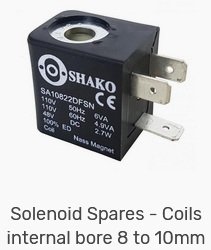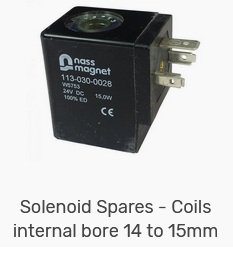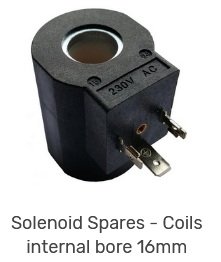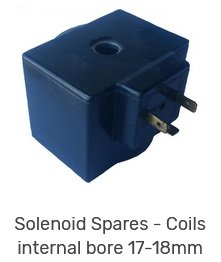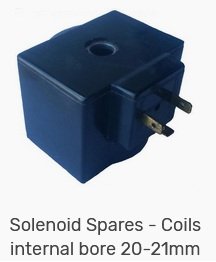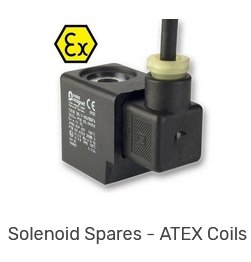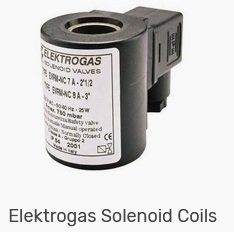Coils
Solenoid valve coil selection chart according to bore size, including ATEX hazardous area coils and Elektrogas coils.
Voltages 6vDC, 12vDC, 24vDC, 36vDC, 48vDC, 110vDC, 80vDC, 125vDC, 220vDC and 12vAC, 24vAC, 36vAC, 48vAC, 110vAC, 230vAc and 380vAC. See all our solenoid coils here.
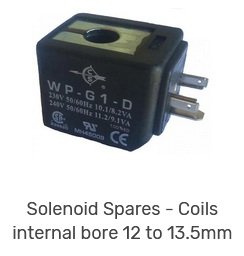
Solenoid Valve Coils.
A solenoid valve coil is designed to convert electrical energy into lateral motion. The coil usually consists of copper wire wound around a hollow bobine or tube, so when electric current flows through the coil, a magnetic field is generated. By placing a solenoid valve coil over a ferromagnetic core (usually magnetic 430F stainless steel armature) the magnetic field generated causes the plunger to slide further up towards the magnetic field (into the coil) thus allowing an opening to be created. This in turn can be utilised to either to control direct acting solenoid valves, Assisted Lift Solenoid Valves or Servo/ Pressure Assisted solenoid valves.
Solenoid valve coils come in a huge range of sizes, voltages, IP protection levels, temperature ratings and power levels.
Care needs to be taken when replacing solenoid valve coils because all these factors must be considered.
Solenoid Coil Sizing.
When measuring a coil, you need to measure accurately the internal diameter of the coil (as above). Some solenoid coils may be fitted with a top plate with a reduced diameter to aid secure fitment to the armature / core tube. Then the depth of the internal core needs to be measured. If this matches up, you are at the first step of finding the right coil. Helpful hint - when buying solenoid valve coils, try to replace according to brand.
Solenoid Coil Voltages.
Coils are manufactured for specific voltages, it is very rare that a coil will work on more than 1 voltage, whether it be AC or DC. There are some instances of "Dual voltage coils" which can work on for example 12vDC or 24vAC, 48vDC or 24vAC but these are quite rare and this cannot be relied on to overcome spares shortfalls.
Helpful hint - check your supply voltage rather than guessing or trying to read the coil voltage.
Solenoid Coil Temperature Ratings.
Coil winding's have several temperature classes and are usually designed depending on the media, ambient temperatures and duty cycle (duty cycle being the power on time and power off cool downtime) as all coils generate heat when energised a bit like a light bulb the more power they consume the hotter they will get.
Standard coils are available for insulation classes E, F and H. The insulation class determines the coil maximum operating temperature for a specific life expectancy.
Class H: 30 000 hours-Class F: 20 000 hours
Class F coils are rated to 155°C, basically the copper wire windings can withstand a working temperature up to but not exceeding 155°C. These are the most common form of solenoid coil used in the pneumatic industry and are ideally suited to working ambient temperatures up to 20°C and media up to 100°C.
Class H coils are rated to 180°C, basically the copper wire windings can withstand a working temperature up to but not exceeding 180°C. These are the most common form of solenoid coil for higher temperature applications such as steam or hot oil with working ambient temperatures up to 50°C and media up to 180°C.
Class N coils are rated to 200°C, basically the copper wire windings can withstand a working temperature up to but not exceeding 200°C. These are the most common form of solenoid coil for extreme applications such as super heated steam and ambient temperatures up to 80°C and media up to 200°C.
Helpful hint - replace brand like for like if experiencing short solenoid coil life, check supply voltage and application temperature parameters and make sure none of the internals where the coil sits are stuck or contaminated.
Power Levels for solenoid coils
Solenoid coils come in a range of power levels, DC coils are measured in Watts, AC coils measured in VA (Volt Amps) and will have a higher Inrush current and lower Holding Current. It is a bit like weight lifting, lifting a weight requires more energy than holding it up with arms locked.
Helpful hint Watts = Volts x Amps.
You need to pay attention to the power ratings, underrated coils will over load and burn out and too higher power rating may well do the same.
Helpful hint - try to stay with the same power level unless the coil fails quickly then check voltage supply and current availability then if need be consult your supplier.
Why do solenoid coils burn out?
Solenoid coils are designed to convert electrical energy into mechanical movement by means of a magnet field, which means as they consume power like a light bulb for example they will become hot, and the higher the wattage or power consumption or the longer they are switched ON the hotter they can become.
If the coil becomes too hot or above its temperature rating (copper winding class rating) the copper or insulating material can fail to short circuit.
Other reasons include high media or ambient temperatures preventing the coil from cooling sufficiently, water ingress between armature and coil or if the coil is removed whilst energised!!
Why does a coil get burnt when removed from valve?
This is because with AC 50/60Hz coils you are reducing the impedance or resistance of the coil, as the shading ring within the armature or stem generates resistance within the coil. By removing the coil whilst powered the resistance is reduced thus the power consumption can easily increase above the coil winding class limits causing over heating.
Solenoid Coil Duty Rating.
Duty rating (duty cycle being the power on time and power off cool down time).
The duty cycle of a solenoid coil is expressed as a percentage of the coil power off time (cooling time) divided by the time powered ON + time power off (cooling) x 100 to give a percentage.
Duty Cycle = Time OFF / (Time ON + Time Off) x 100
Example: Coil powered ON for 15 seconds and then switched / powered OFF (cooling time) for 45 seconds before powered ON again then the cycle time is calculated as:- Duty cycle = 45 seconds / (15 ON + 45 OFF) x100 Duty Cycle = 45 / 60 x 100 Duty Cycle = 75%
Example: Power ON 2 minutes then power off 2 Minutes. Duty Cycle = 2 / (2+2) x 100 Duty Cycle = 50%
Solenoid Coil IP Protection Levels
Solenoid coils come with a wide range of IP (Ingress Protection) ratings according to general protection and Dust and Water Ingress. Please find below a basic IP Protection chart.

Some examples of standard solenoid coil types are shown below.

